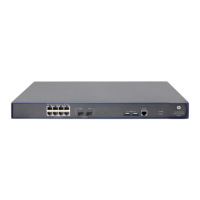196
Layer 3 Ethernet interfaces do not support IEEE 802.1 organizationally specific TLVs.
3. IEEE 802.3 organizationally specific TLVs
Table 70 IEEE 802.3 organizationally specific TLVs
T
MAC/PHY
Configuration/Status
Contains the rate and duplex capabilities of the sending port, support for auto
negotiation, enabling status of auto negotiation, and the current rate and duplex
mode.
Power Via MDI
Contains the power supply capability of the port, including the PoE type, which
can be PSE or PD, PoE mode, whether PSE power supply is supported, whether
PSE power supply is enabled, and whether the PoE mode is controllable.
Link Aggregation
Indicates the support of the port for link aggregation, the aggregation capability
of the port, and the aggregation status (or whether the link is in an aggregation).
Maximum Frame Size Indicates the supported maximum frame size. It is now the MTU of the port.
Power Stateful Control
Indicates the power state control configured on the sending port, including the
power type of the PSE/PD, PoE sourcing/receiving priority, and PoE
sourcing/receiving power.
The Power Stateful Control TLV is defined in IEEE P802.3at D1.0. The later versions no longer support this
TLV. The device sends this type of TLVs only after receiving them.
LLDP-MED TLVs
LLDP-MED TLVs provide multiple advanced applications for VoIP, such as basic configuration, network
policy configuration, and address and directory management. LLDP-MED TLVs satisfy the voice device
vendors' requirements for cost effectiveness, ease of deployment, and ease of management. In addition,
LLDP-MED TLVs make deploying voice devices in Ethernet easier. LLDP-MED TLVs are shown in Table 71.
Table 71 LLDP-MED TLVs
T
LLDP-MED Capabilities Allows a network device to advertise the LLDP-MED TLVs that it supports.
Network Policy
Allows a network device or terminal device to advertise the VLAN ID of the specific
port, the VLAN type, and the Layer 2 and Layer 3 priorities for specific applications.
Extended
Power-via-MDI
Allows a network device or terminal device to advertise power supply capability.
This TLV is an extension of the Power Via MDI TLV.
Hardware Revision Allows a terminal device to advertise its hardware version.
Firmware Revision Allows a terminal device to advertise its firmware version.
Software Revision Allows a terminal device to advertise its software version.
Serial Number Allows a terminal device to advertise its serial number.
Manufacturer Name Allows a terminal device to advertise its vendor name.
Model Name Allows a terminal device to advertise its model name.
Asset ID
Allows a terminal device to advertise its asset ID. The typical case is that the user
specifies the asset ID for the endpoint to help directory management and asset
tracking.
Location Identification
Allows a network device to advertise the appropriate location identifier information
for a terminal device to use in the context of location-based applications.

